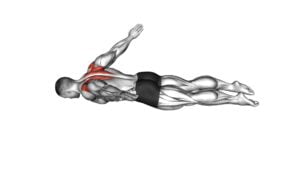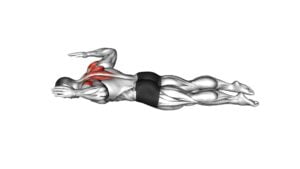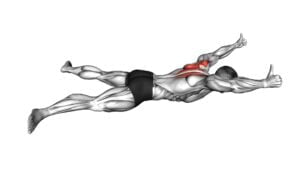Bodyweight Lying Prone Ys – Video Exercise Guide & Tips

Are you looking for an effective exercise to strengthen your upper back? Look no further than bodyweight lying prone Ys!
Watch This Exercise Video
In this video exercise guide, we'll show you the proper form and technique to perform this exercise and activate your upper back muscles.
We'll also share variations to challenge yourself and tips to avoid common mistakes.
Get ready to incorporate bodyweight lying prone Ys into your workout routine and see the benefits for yourself!
Key Takeaways
- Increased shoulder mobility
- Improved flexibility and range of motion in the shoulders and upper back
- Promotes proper posture and spinal alignment
- Helps prevent slouching and rounded shoulders
Benefits of Bodyweight Lying Prone Ys
You can experience several benefits from incorporating bodyweight lying prone Ys into your workout routine.
One of the main benefits is increased shoulder mobility. By performing this exercise, you engage the muscles in your shoulders and upper back, helping to improve their flexibility and range of motion. This can be especially beneficial if you have a sedentary lifestyle or spend long hours sitting at a desk.
Another benefit of bodyweight lying prone Ys is improved posture and spinal alignment. This exercise targets the muscles in your upper back and shoulders, which are responsible for maintaining proper posture. By strengthening these muscles, you can help prevent slouching and rounded shoulders, promoting a more upright and aligned spine.
Incorporating bodyweight lying prone Ys into your workout routine is a simple and effective way to reap these benefits. You can do this exercise anywhere, without the need for any equipment. Start by lying face down on the floor with your arms extended overhead in a Y shape. Lift your chest and arms off the floor, squeezing your shoulder blades together. Hold for a few seconds, then slowly lower back down. Repeat for the desired number of repetitions.
Incorporating bodyweight lying prone Ys into your routine can help you increase shoulder mobility and improve your posture and spinal alignment. So give it a try and start reaping the benefits today.
Proper Form and Technique
To ensure proper form and technique for bodyweight lying prone Ys, it's important to maintain controlled movements throughout the exercise. This ensures that you engage the correct muscles and maximize the benefits of the exercise.
One common mistake to avoid is using momentum to lift your arms instead of relying on the strength of your muscles. It's crucial to perform the movement slowly and under control, focusing on the contraction of your shoulder blades and upper back muscles. This will help activate and strengthen those muscles effectively.
Additionally, it's important to maintain a neutral spine throughout the exercise. Avoid arching or rounding your back, as this can put unnecessary strain on your spine and decrease the engagement of your target muscles.
To engage the muscles properly, start by lying face down on the ground with your arms extended in a Y position overhead. Keep your legs straight and lift your chest, arms, and head off the ground while squeezing your shoulder blades together. Hold this position for a moment and then slowly lower back down.
Variations to Challenge Yourself
For an added challenge, try incorporating different variations of bodyweight lying prone Ys. These advanced modifications and progression options will help you take your workout to the next level.
One way to increase the difficulty is by using weights. Instead of just using your bodyweight, hold a dumbbell or a resistance band in each hand while performing the exercise. This added resistance will engage your muscles even more and provide a greater challenge.
Another variation you can try is to lift your legs off the ground while doing the exercise. This won't only target your back and shoulder muscles but also engage your core and lower body for a full-body workout.
If you're looking for an even greater challenge, you can incorporate a stability ball into the exercise. By placing your chest on the stability ball and performing the lying prone Ys, you'll have to work harder to maintain your balance, which will engage more muscles and further enhance the effectiveness of the exercise.
Remember to always listen to your body and progress at a pace that's comfortable for you. Start with the basic bodyweight lying prone Ys and gradually work your way up to the advanced modifications. With consistency and dedication, you'll be able to challenge yourself and achieve your fitness goals.
Common Mistakes to Avoid
Be mindful of the following errors when performing bodyweight lying prone Ys to ensure proper form and maximize the effectiveness of the exercise.
- Raising your head too high: When doing bodyweight lying prone Ys, it's important to avoid lifting your head too high. Doing so can strain your neck and put unnecessary pressure on your spine. Instead, keep your head in a neutral position throughout the exercise, with your gaze directed towards the floor.
- Arching your lower back: Another common mistake is arching your lower back during the movement. This not only reduces the effectiveness of the exercise but also puts strain on your lower back. To maintain proper form, engage your core muscles and keep your back flat throughout the entire range of motion.
- Lifting your legs too high: While it may be tempting to lift your legs as high as possible during bodyweight lying prone Ys, it's important to avoid this mistake. Lifting your legs too high can lead to excessive strain on your lower back and compromise your form. Instead, focus on lifting your legs to a comfortable height while keeping proper alignment of your spine.
Tips for Effective Upper Back Activation
To effectively activate your upper back during the Bodyweight Lying Prone Ys exercise, it's important to focus on proper form and engage the correct muscles. Start by lying face down with your arms extended overhead, palms facing down.
As you lift your arms up into a Y shape, concentrate on squeezing your shoulder blades together and using your upper back muscles to initiate the movement. These cues will help ensure that you're effectively activating your upper back and getting the most out of the exercise.
Proper Form Technique
When performing the Bodyweight Lying Prone Ys exercise, focus on squeezing your shoulder blades together and lifting your arms up and out to the sides. This will help activate your upper back muscles effectively.
Here are some tips to ensure proper form technique and maximize muscle engagement:
- Keep your neck in a neutral position to avoid straining it.
- Engage your core muscles to maintain stability throughout the exercise.
- Control the movement and avoid using momentum to ensure proper muscle activation.
By following these tips, you can ensure that you're performing the Bodyweight Lying Prone Ys exercise with proper form and technique, leading to effective upper back activation.
Remember to listen to your body and adjust the exercise intensity as needed.
Muscle Engagement Cues
To maximize upper back activation during the Bodyweight Lying Prone Ys exercise, focus on engaging both your shoulder blades and lifting your arms up and out to the sides. By consciously activating your shoulder blades, you can ensure that your upper back muscles are being properly engaged throughout the movement.
Imagine squeezing your shoulder blades together as you lift your arms, feeling the muscles in your upper back working. This will help to strengthen and tone your upper back, improving posture and overall upper body strength.
Additionally, you can modify the exercise by using lighter weights or no weights at all, especially if you're a beginner or have any shoulder or back issues. The key is to focus on proper muscle activation and form to get the most out of this exercise.
Incorporating Bodyweight Lying Prone Ys Into Your Workout Routine
To effectively incorporate bodyweight lying prone Ys into your workout routine, focus on engaging your core and upper back muscles. This exercise is great for improving core stability and strengthening your upper body. Here are some tips to help you get the most out of this exercise:
- Start with proper form: Lie face down on a mat or the floor with your arms extended overhead and your legs straight. Keep your neck in a neutral position and engage your core muscles.
- Modify as needed: If you're new to this exercise or have limited upper body strength, you can bend your elbows and perform the movement with your forearms on the ground instead of fully extending your arms.
- Gradually increase difficulty: As you become more comfortable with the exercise, you can progress by using light dumbbells or resistance bands to add extra resistance and challenge your muscles.
Incorporating bodyweight lying prone Ys into your workout routine can help improve your posture, strengthen your upper back muscles, and enhance core stability. Remember to listen to your body and start with a weight or modification that's appropriate for your fitness level. As always, consult with a fitness professional if you have any concerns or questions.
Frequently Asked Questions
How Many Sets and Reps Should I Do When Incorporating Bodyweight Lying Prone Ys Into My Workout Routine?
When incorporating bodyweight lying prone Ys into your workout routine, it's important to consider how many reps and sets to do.
By doing 2-3 sets of 10-15 reps, you can effectively target your back muscles and improve your posture.
Bodyweight lying prone Ys are a great exercise for strengthening the muscles that support your spine and promoting better alignment.
Can Bodyweight Lying Prone Ys Help Improve Posture?
Bodyweight lying prone Ys can definitely help improve your posture. By targeting the muscles in your upper body, these exercises can strengthen your back, shoulders, and core, which are all important for maintaining good posture.
In fact, bodyweight lying prone Ys are often compared to other exercises like rows and pull-ups for their effectiveness in improving posture. So, incorporating them into your workout routine can have positive effects on your upper body strength and overall posture.
Are There Any Modifications or Progressions for Beginners or Those With Limited Mobility?
If you're a beginner or have limited mobility, don't worry! There are modifications and progressions available for the bodyweight lying prone Ys exercise. These variations can help you adapt the movement to your current fitness level and improve over time.
By starting with easier modifications and gradually progressing to more challenging variations, you can gradually build strength, flexibility, and overall mobility.
Keep pushing yourself, and you'll see improvements in no time!
Can Bodyweight Lying Prone Ys Be Beneficial for Individuals With Lower Back Pain?
Bodyweight lying prone Ys can be beneficial for individuals with lower back pain. These exercises target both core stability and shoulder strength. By strengthening the muscles in your back and shoulders, you can improve your overall posture and reduce strain on your lower back.
However, it's important to consult with a healthcare professional before starting any new exercise program, especially if you have lower back pain. They can provide guidance on modifications or alternatives that may be more suitable for your specific needs.
Can Bodyweight Lying Prone Ys Be Performed With Additional Resistance, Such as Using Dumbbells or Resistance Bands?
Yes, you can definitely add additional resistance to your bodyweight lying prone Ys exercise. You can use dumbbells or resistance bands to increase the intensity and challenge your muscles even more.
This can help you build strength and improve your overall fitness level. However, if you find this exercise too difficult or if you have any discomfort, there are alternative exercises you can try that target the same muscle groups.
Conclusion
In conclusion, bodyweight lying prone Ys are a beneficial exercise for activating and strengthening the upper back muscles. By maintaining proper form and technique, you can maximize the effectiveness of this exercise.
Additionally, incorporating variations and avoiding common mistakes will help challenge yourself and prevent injury.
With these tips in mind, you can easily incorporate bodyweight lying prone Ys into your workout routine to improve your upper body strength and posture.

Author
Years ago, the spark of my life’s passion ignited in my mind the moment I stepped into the local gym for the first time. The inaugural bead of perspiration, the initial endeavor, the very first surge of endorphins, and a sense of pride that washed over me post-workout marked the beginning of my deep-seated interest in strength sports, fitness, and sports nutrition. This very curiosity blossomed rapidly into a profound fascination, propelling me to earn a Master’s degree in Physical Education from the Academy of Physical Education in Krakow, followed by a Sports Manager diploma from the Jagiellonian University. My journey of growth led me to gain more specialized qualifications, such as being a certified personal trainer with a focus on sports dietetics, a lifeguard, and an instructor for wellness and corrective gymnastics. Theoretical knowledge paired seamlessly with practical experience, reinforcing my belief that the transformation of individuals under my guidance was also a reflection of my personal growth. This belief holds true even today. Each day, I strive to push the boundaries and explore new realms. These realms gently elevate me to greater heights. The unique combination of passion for my field and the continuous quest for growth fuels my drive to break new ground.







